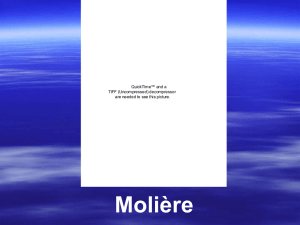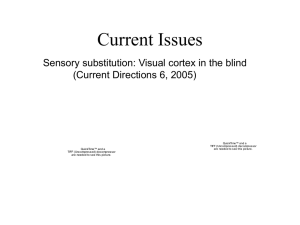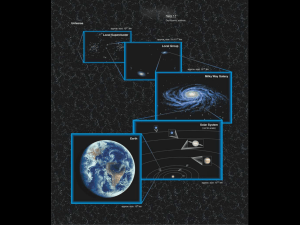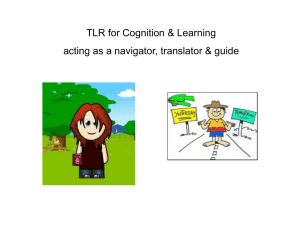Chapter 4
advertisement
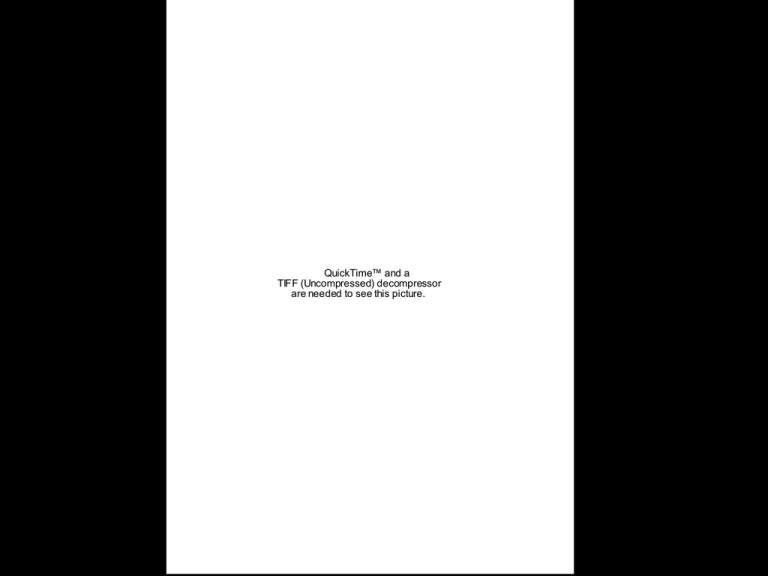
QuickTime™ and a TIFF (Uncompressed) decompressor are needed to see this picture. QuickTime™ and a TIFF (Uncompressed) decompressor are needed to see this picture. QuickTime™ and a TIFF (Uncompressed) decompressor are needed to see this picture. QuickTime™ and a TIFF (Uncompressed) decompressor are needed to see this picture. QuickTime™ and a TIFF (Uncompressed) decompressor are needed to see this picture. QuickTime™ and a TIFF (Uncompressed) decompressor are needed to see this picture. QuickTime™ and a TIFF (Uncompressed) decompressor are needed to see this picture. Lunar eclipse: is the moon rising or setting? QuickTime™ and a TIFF (Uncompressed) decompressor are needed to see this picture. QuickTime™ and a TIFF (Uncompressed) decompressor are needed to see this picture. What’s wrong with this picture? Chapter 4 The origin of modern astronomy Copernicus, Kepler, and Galileo challenged the geocentric model Copernicus (1473-1543): • • Published heliocentric model (1543) Used model to determine arrangement of solar system • Much simpler than geocentric!! • Assumed circular orbits But . . . • Heliocentric model was no more accurate than geocentric model in predicting planetary positions Tycho Brahe (1546-1601) • Believed earth was at center • Compiled very accurate measurements of star and planet positions. • could not detect stellar parallax • Concluded earth is at center, but planets orbit the sun • Hired Kepler, who used Tycho’s observations to discover the truth about planetary motion. • Kepler tried to explain Tycho’s observations with circular orbits • But Mars’ orbit was not circular! • Kepler found that it is elliptical. Johannes Kepler (1571-1630) Ellipse a Kepler’s three laws of planetary motion Kepler’s First Law: The orbit of each planet around the Sun is an ellipse with the Sun at one focus. a Perihelion = a(1-e) Aphelion = a(1+e) Kepler’s Second Law: As a planet orbits the Sun, it sweeps out equal areas in equal times. a planet travels faster when it is closer to the Sun and slower when it is farther from the Sun. Kepler’s Third Law Kepler’s Third Law More distant planets orbit the Sun at slower speeds 3 a 1 2 p p = orbital period in years a = avg. distance from Sun in AU 1 AU = astronomical unit = 150 million km = average earth-sun distance Thought Question: An asteroid orbits the Sun at an average distance a = 4 AU. How long does it take to orbit the Sun? A. B. C. D. 4 years 8 years 16 years 64 years Hint: Remember that p2 = a3 An asteroid orbits the Sun at an average distance a = 4 AU. How long does it take to orbit the Sun? A. B. C. D. 4 years 8 years 16 years 64 years We need to find p so that p2 = a3 Since a = 4, a3 = 43 = 64 Therefore p = 8, p2 = 82 = 64 Galileo Galilei (1564-1642) Before Galileo, it was “obvious” that 1. Earth could not be moving because objects in air would be left behind. 2. Non-circular orbits are not “perfect” as heavens should be. 3. If Earth were really orbiting Sun, we’d detect stellar parallax. Parallax If you can’t see it, is it because it is too small, or does not exist? Do all moving objects eventually slow down on their own? • Galileo showed that objects will stay in motion unless another object acts on them (Newton’s first law of motion). What about “heavenly perfection”? Tycho’s observations of comets and a supernova already challenged this idea. Using his telescope, Galileo saw: What about the lack of stellar parallax? • Tycho thought he knew the distances to stars, so lack of parallax meant Earth stands still. • Galileo showed stars must be much farther than Tycho thought — used his telescope to show that the Milky Way is countless individual stars. •He could still not measure parallax! Galileo discovered four large moons orbiting Jupiter Venus has phases similar to the Moon! Galileo’s observations of phases of Venus proved that it orbits the Sun and not Earth. in 1633, the Catholic Church ordered Galileo to recant his claim that Earth orbits the Sun His book on the subject was removed from the Church’s index of banned books in 1824 Galileo Galilei Galileo was formally vindicated by the Church in 1992 • How did Copernicus, Tycho and Kepler challenge the Earth-centered idea? – Copernicus created a sun-centered model – Tycho provided the data needed to improve this model – Kepler found a model that fit Tycho’s data • Kepler’s three laws of planetary motion – 1. The orbit of each planet is an ellipse with the Sun at one focus – 2. As a planet moves around its orbit it sweeps our equal areas in equal times – 3. More distant planets orbit the Sun at slower average speeds: p2 = a3 • What was Galileo’s role in solidifying the Copernican revolution? – His experiments and observations overcame the remaining objections to the Sun-centered solar system 3.4 The Nature of Science • How can we distinguish science from non-science? • What is a scientific theory? • Cognitive bias • Defining science can be surprisingly difficult. • Science from the Latin scientia, meaning “knowledge.” The idealized scientific method • Based on proposing and testing hypotheses • hypothesis = educated guess But science rarely proceeds in this idealized way… For example: • Sometimes we start by “just looking” then coming up with possible explanations. • Sometimes we follow our intuition rather than a particular line of evidence. Hallmarks of Science: #1 Modern science seeks explanations for observed phenomena that rely solely on natural causes. (A scientific model cannot include divine intervention or other supernatural explanations) Hallmarks of Science: #2 Start with the simplest possible model: make predictions, tests and refinements. (Simplicity = “Occam’s razor”) Hallmarks of Science: #3 A scientific model must make testable predictions about natural phenomena that would force us to revise or abandon the model if the predictions do not agree with observations. “No other explanation” does NOT prove anything! What is a scientific theory? • “Theory” has a different meaning in science than in everyday life. • In science, a Theory is NOT just a good idea! • A scientific Theory must: —Explain a wide variety of observations with a few simple principles, AND —Must be supported by a large, compelling body of evidence. —Must NOT have failed any crucial test of its validity. Thought Question: Which of the following is true of Darwin’s Theory of Evolution? A. B. C. D. Scientific opinion is about evenly split as to whether evolution really explains the diversity of life on Earth. Scientific opinion runs about 90% in favor of the theory of evolution and about 10% opposed. After more than 100 years of testing, Darwin’s theory has successfully met every scientific challenge to its validity. In a court of law, there would still be “reasonable doubt” about whether evolution is true: Judicial proof is much harder to achieve than scientific proof. A. Scientific opinion is about evenly split as to whether evolution really happened. B. Scientific opinion runs about 90% in favor of the theory of evolution and about 10% opposed. C. After more than 100 years of testing, Darwin’s theory has successfully met every scientific challenge to its validity. D. There is no longer any doubt that the theory of evolution is absolutely true. Correlation does not prove causation • Events may occur at the same time, but how are they related, if at all? • The hypothesis: Smoking causes lung cancer • More accurate: Smoking dramatically increases one’s chances of developing lung cancer Anecdotes vs. Studies • Anecdotal evidence: “My grandmother smoked a pack a day for 60 years, she lived to be 75.” • Scientific study: Monitor the health of 1000 smokers and non-smokers for 20 years. Compare rates of lung cancer, longevity, etc. Power of suggestion Have you heard claims that vaccines can sometimes cause autism in children? Which of the following is true: 1. Studies show that there is a slight risk of developing autism due to vaccines but the benefit outweighs the risk 2. Studies have shown that there is no cause-andeffect relationship between vaccines and autism 3. Studies into the proposed links between autism and vaccines have not yet been conducted What have we learned? • How can we distinguish science from non-science? – Science seeks explanations that rely solely on natural causes – progresses through development and testing of models of nature – models must make testable predictions • A scientific theory – A model that explains a wide variety of observations in terms of a few general principles – Has survived repeated and varied testing – Subject to modification as new data and observations are acquired 3.5 Astrology Our goals for learning: • How is astrology different from astronomy? • Does astrology have any scientific validity? How is astrology different from astronomy? • Astronomy is a science focused on learning about how stars, planets, and other celestial objects work. • Astrology is a search for hidden influences on human lives based on the positions of planets and stars in the sky. Does astrology have any scientific validity? • Scientific tests have shown that astrological predictions are no more accurate than we should expect from pure chance. What have we learned? • How is astrology different from astronomy? – Astronomy is the scientific study of the universe and the celestial objects within it. – Astrology assumes that the positions of celestial objects influence human events. • Does astrology have any scientific validity? – Scientific tests show that the predictions of astrology are no more accurate than pure chance.

